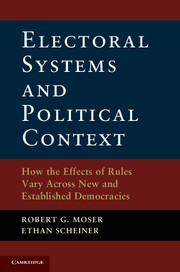 Electoral Systems and Political Context
Electoral Systems and Political Context What We Actually See
Published online by Cambridge University Press: 05 November 2012
In Chapter 3, we set up a number of variables and expectations regarding disproportionality and the number of parties. In this chapter, we now take advantage of the simultaneous existence of PR and SMD rules in mixed-member systems across a range of established and new democracies to investigate the extent to which these expectations bear out in reality.
We examine four key electoral outcomes: (1) disproportionality (LSq), the most common measure of the mechanical effect of electoral rules, (2) the constraining effect of SMDs on the number of parties, as measured by the mean effective number of candidates in SMDs (Ncands), (3) the psychological effect, as measured by the difference – within SMDs – between the effective number of parties winning votes under PR balloting and the effective number of candidates winning votes in SMD balloting (Nparties minus Ncands), and (4) the projection of district-level party configurations to the national level, as measured by the nationally aggregated effective number of parties receiving SMD votes and the effective number of candidates at the district level receiving SMD votes (Nv SMD minus Ncands).
In each of these cases, we expect democratic experience and party system development to condition the effects of electoral rules. More specifically, we expect that, compared with established democracies, in new democracies disproportionality will be higher, SMDs will lead to a weaker psychological effect that promotes a larger number of parties, and there will be less matching between the number of parties at the district and national levels. Indeed, in this chapter we find that these expectations bear out.
To save this book to your Kindle, first ensure [email protected] is added to your Approved Personal Document E-mail List under your Personal Document Settings on the Manage Your Content and Devices page of your Amazon account. Then enter the ‘name’ part of your Kindle email address below. Find out more about saving to your Kindle.
Note you can select to save to either the @free.kindle.com or @kindle.com variations. ‘@free.kindle.com’ emails are free but can only be saved to your device when it is connected to wi-fi. ‘@kindle.com’ emails can be delivered even when you are not connected to wi-fi, but note that service fees apply.
Find out more about the Kindle Personal Document Service.
To save content items to your account, please confirm that you agree to abide by our usage policies. If this is the first time you use this feature, you will be asked to authorise Cambridge Core to connect with your account. Find out more about saving content to Dropbox.
To save content items to your account, please confirm that you agree to abide by our usage policies. If this is the first time you use this feature, you will be asked to authorise Cambridge Core to connect with your account. Find out more about saving content to Google Drive.